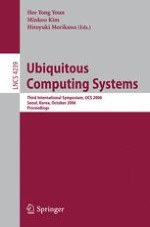We cordially welcome you to the proceedings of the 2006 International Symposium on Ubiquitous Computing Systems (UCS) held in Seoul, Korea. UCS has been a symposium for dissemination of state-of-the-art research and engineering practices in ubiquitous computing with particular emphasis on systems and software. 2006 UCS was the third of this series of international symposia, and its importance is increasing as information technology industries are recognizing ubiquitous systems to be one of their top priorities. This year the symposium was organized by u-Korea Forum, Su- kyunkwan University, The Electronic Times, and UCN, Korea. It was also sponsored by the Korea Ministry of Information and Communication, KISS, KIPS, KICS, NCA from Korea and IPSJ SIGUBI, IEICE URON, and UNF from Japan. This year we attracted 359 high-quality paper submissions from all over the world. Among them, 41 papers representing 11 countries were selected to be included in the technical program. This very low acceptance rate of about 11% clearly demonstrates the high quality of the conference, and this tradition will continue in the upcoming years. Three distinguished speakers were also invited for keynote speeches, who enlightened the audience on ubiquitous computing theory and application.
